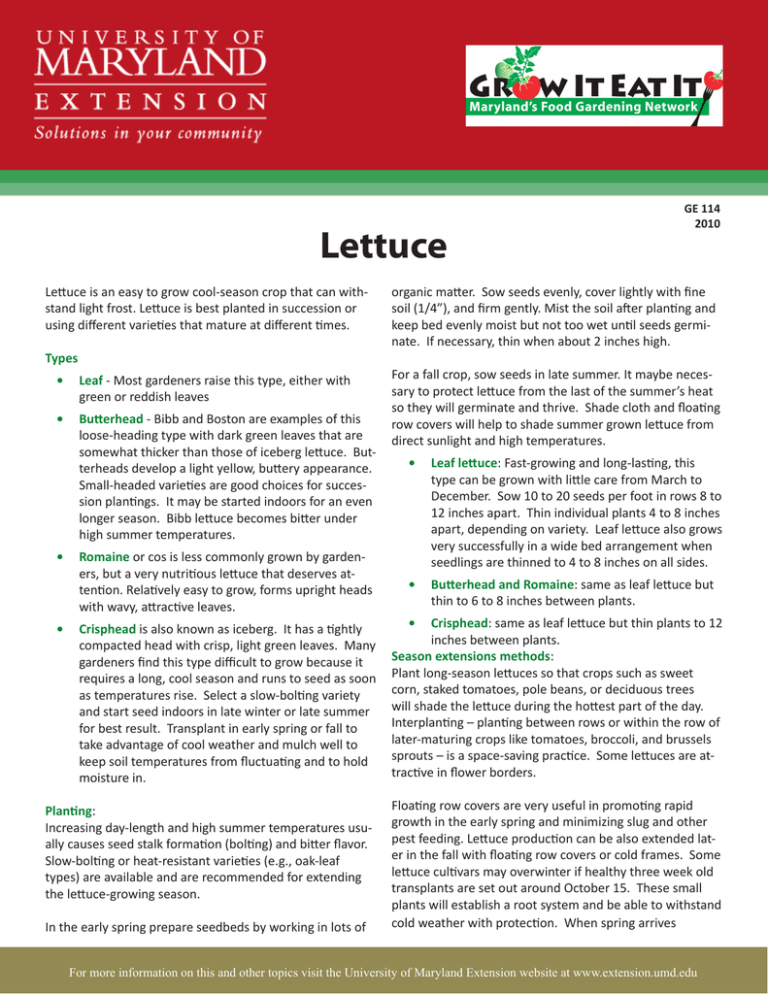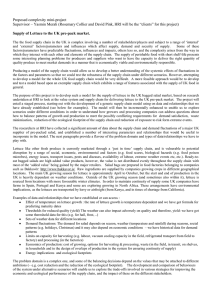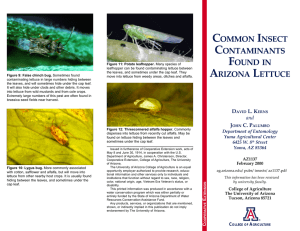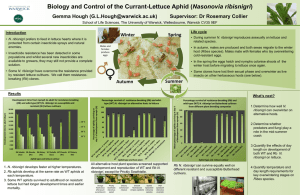Lettuce
advertisement

Lettuce Lettuce is an easy to grow cool-season crop that can withstand light frost. Lettuce is best planted in succession or using different varieties that mature at different times. Types • Leaf - Most gardeners raise this type, either with green or reddish leaves • Butterhead - Bibb and Boston are examples of this loose-heading type with dark green leaves that are somewhat thicker than those of iceberg lettuce. Butterheads develop a light yellow, buttery appearance. Small-headed varieties are good choices for succession plantings. It may be started indoors for an even longer season. Bibb lettuce becomes bitter under high summer temperatures. • Romaine or cos is less commonly grown by gardeners, but a very nutritious lettuce that deserves attention. Relatively easy to grow, forms upright heads with wavy, attractive leaves. GE 114 2010 organic matter. Sow seeds evenly, cover lightly with fine soil (1/4”), and firm gently. Mist the soil after planting and keep bed evenly moist but not too wet until seeds germinate. If necessary, thin when about 2 inches high. For a fall crop, sow seeds in late summer. It maybe necessary to protect lettuce from the last of the summer’s heat so they will germinate and thrive. Shade cloth and floating row covers will help to shade summer grown lettuce from direct sunlight and high temperatures. • Leaf lettuce: Fast-growing and long-lasting, this type can be grown with little care from March to December. Sow 10 to 20 seeds per foot in rows 8 to 12 inches apart. Thin individual plants 4 to 8 inches apart, depending on variety. Leaf lettuce also grows very successfully in a wide bed arrangement when seedlings are thinned to 4 to 8 inches on all sides. • Butterhead and Romaine: same as leaf lettuce but thin to 6 to 8 inches between plants. • Crisphead is also known as iceberg. It has a tightly compacted head with crisp, light green leaves. Many gardeners find this type difficult to grow because it requires a long, cool season and runs to seed as soon as temperatures rise. Select a slow-bolting variety and start seed indoors in late winter or late summer for best result. Transplant in early spring or fall to take advantage of cool weather and mulch well to keep soil temperatures from fluctuating and to hold moisture in. • Crisphead: same as leaf lettuce but thin plants to 12 inches between plants. Season extensions methods: Plant long-season lettuces so that crops such as sweet corn, staked tomatoes, pole beans, or deciduous trees will shade the lettuce during the hottest part of the day. Interplanting – planting between rows or within the row of later-maturing crops like tomatoes, broccoli, and brussels sprouts – is a space-saving practice. Some lettuces are attractive in flower borders. Planting: Increasing day-length and high summer temperatures usually causes seed stalk formation (bolting) and bitter flavor. Slow-bolting or heat-resistant varieties (e.g., oak-leaf types) are available and are recommended for extending the lettuce-growing season. Floating row covers are very useful in promoting rapid growth in the early spring and minimizing slug and other pest feeding. Lettuce production can be also extended later in the fall with floating row covers or cold frames. Some lettuce cultivars may overwinter if healthy three week old transplants are set out around October 15. These small plants will establish a root system and be able to withstand cold weather with protection. When spring arrives In the early spring prepare seedbeds by working in lots of For more information on this and other topics visit the University of Maryland Extension website at www.extension.umd.edu they will begin active growth and produce early harvests. Some recommended cultivars for overwintering include Black Seeded Simpson, Waldmann’s Dark Green, Salad Bowl, Winter Density, Brune D’Hiver, Winter Marvel, and Arctic King. Cultivation: • Fertilizing: Medium-heavy feeder. Work in lots of organic matter prior to planting. Use starter fertilizer on transplants, side dress every week after planting with compost tea or balanced liquid fertilizer. • Weeding: Cultivate carefully, as lettuce is shallowrooted. Organic mulches (e.g. sections of newspaper covered with straw or grass clippings) are helpful in maintaining soil moisture and preventing soil-borne diseases. • Watering: Use frequent, light watering to encourage rapid growth, but do not over-water, as this may contribute to root and leaf diseases. Overhead watering should always be done in the morning to give plants time to dry off. Harvesting: • Crisphead is mature when leaves overlap to form a head similar to those available in groceries; heads will be compact and firm. Cut and Come Again Harvesting: For continuous harvests of quick and easy salad greens. Sow a raised bed thickly with a mixture of your favorite salad greens (with maturity dates close to one another). Shear the plants with sharp scissors when they are 6 to 10 inches tall. Take off 2 to 4 inches or cut them to the crown. They will quickly re-grow if watered and fertilized and be ready to cut a second time 2-3 weeks later. Sow a second bed. Turn under the plants when they become overlymature and bitter. Approximate Yield (per 10 foot row): 5-10 lbs. Storage and Preservation: Storage: Very cool (32 degrees F), moist (95% RH) conditions; 2-3 weeks. Crisphead lettuce will keep about two weeks in the refrigerator. Leaf and Bibb will store as long as four weeks if the leaves are dry when bagged. If lettuce is to be stored, harvest when dry, remove outer leaves but do not wash, place in a plastic bag, and store in the crisper drawer. • Leaf lettuce can be used as soon as plants are 5 to 6 inches tall. Use the older, outer leaves which contain high levels of calcium first. You may wish to harvest every other one of the largest plants to accomplish thinning. Nutrition: Green leaf lettuce is a good source of vitamins A, C, K and folate and the mineral manganese as well as certain phytonutrients. • Bibb lettuce is mature when the leaves begin to cup inward to form a loose head. Preparation and use: Prepare by rinsing in cool water. Pat dry and tear into bite size pieces. Cutting lettuce leaves with a metal knife turns the edges brown. Use in salads, adding dressing just before serving to prevent wilting. • Romaine or cos is ready to use when the leaves have elongated and overlapped to form a fairly tight head about 4 inches wide at the base and 6 to 8 inches tall. Do you have a plant or insect pest question? Visit us at extension.umd.edu/hgic and click Ask Maryland’s Garden Experts Author: Jon Traunfeld, University of Maryland Extension Specialist, Home and Garden Information Center ,Vegetables & Fruits; Anne Abend and Peggy Yen, University of Maryland Extension Master Gardeners. This publication, GE 114, is a series of publications of the University of Maryland Extension and The Home and Garden Information Center. For more information on related publications and programs, http://extension.umd.edu/hgic. Please visit http://extension.umd.edu/ to find out more about Extension programs in Maryland. The University of Maryland, College of Agriculture and Natural Resources programs are open to all and will not discriminate against anyone because of race, age, sex, color, sexual orientation, physical or mental disability, religion, ancestry, or national origin, marital status, genetic information, or political affiliation, or gender identity and expression. 2 For more information on this and other topics visit the University of Maryland Extension website at www.extension.umd.edu 3 For more information on this and other topics visit the University of Maryland Extension website at www.extension.umd.edu




